| Author |
Message |
Jean Thibodeau

|
 Posted: Sun 08 Jan, 2012 10:16 pm Post subject: Semi custom A&A English Bill. Posted: Sun 08 Jan, 2012 10:16 pm Post subject: Semi custom A&A English Bill. |
 |
|
I really liked the A&A English Bill and decided a while ago to order a customized version of it: Mostly, asked for heat treated rather than the standard not heat treated version.
http://www.arms-n-armor.com/pole030.html
I ordered the head only and mounted it myself onto an 1 1/4" pole that I reduced the diameter to 1 1/8 to fit into the socket.
The outside of the socket is not completely flush with the outside of my pole while the standard version by A&A uses an 1 1/8" pole.
Mine is a bit shorter overall at 79" compared to the standard A&A model which is stated on the site at being 83".
Craig also made some minor changes to the standard model that I was very pleased with:
A) The main axe blade part below the sickle hook has a bit of subtle belly rather than being strait.
B) The tip of the sickle/hook has a reinforced tip of surprising design that Craig told me he discovered on some period Bills and decided to add this feature to my custom version: This reinforced tip is like a miniature adze cutting edge a bit like a chisel at 90 degrees from the axe to sickle main edge of the Bill.
This would make the tip more robust and I think would really dig into a soft target and grab aggressively at maille or an armour joint at the sacrifice of the last inch or so of sickle edge getting wider and not being sharp.
But the actual adze like/chisel edge is sharp. 
The top spike is sharpened on both sides for about 2/3 of the length of the top spike.
The back spike is also sharp.
One advantage of getting the head unmounted is that in hand it felt very robust and I could also weight it by itself, and it weighs 2 lbs 12 oz.
Mounted the 1/8" thickness of the blade seems thinner but because I could feel it's mass unmounted I know that it is far from fragile !
The steel plate that forms the head is continuous through the socket and it seems like the socket is slotted for the plate to fit into and then welded seamlessly to the plate, this creates a web of 1/8" steel in the tapered part of the socket.
This may not be the way these where put together in period but I think it's stronger this way than if the plate had been cut out and the structural integrity totally due to the welding of the plate to the socket.
The haft was cut with a slot to fit onto this web to be able to have wood in the tapered part of the socket, but could have been cut square but would have been more shallowly fitted into the socket: I don't think this would make any structural difference but I preferred the haft to fit most of the tapered part of the socket.
NOTE: If this description seems a bit hard to understand I made a drawing of it that is in the pics attached to this informal review.
Also, the finish is not the original finish, as I aged the finish using Dijon mustard I left to dry on the head after stippling it on with a wet wipe. I cleaned this with fine synthetic steel wool and repeated this a few times to randomize the " staining " of the steel.
Dijon mustard seems to give a dark grey staining and after cleaning and oiling it doesn't seem to be a rusting process but really a staining that produces a very nice patina of a Bill used and weathered but never left to rust and well taken care of.
I also added on a steel butt that may not have been done historically that I bought from Kult of Athena:
http://www.kultofathena.com/product.asp?item=...r+Butt+Cap
This feels like a solid weapon and quite frankly is probably the scariest weapon I have after I gave the edges just a little extra sharpening. Handling feels both authoritative but not over ponderous and with enough sharp edges to cut, chop or grab in numerous ways as one has a thrusting point, an axe edge, a sickle edge with a reinforced point and a back spike.
I really appreciate that Craig added a few extra custom features based on more recent research, and that A&A seems to constantly upgrade their work when they find new information about the historical weapons on which their catalogue weapons are based.  
I may add more to this review if something I forgot to mention comes to mind or I find other things to add.
 Attachment: 105.26 KB Attachment: 105.26 KB
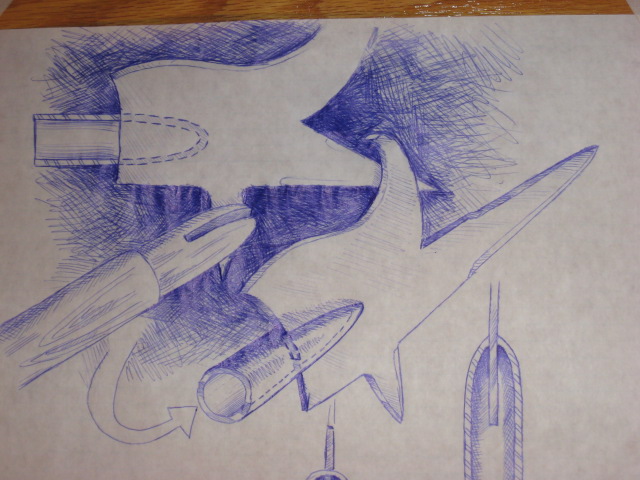
Cross section drawings of socket and the way the haft was carved to fit.
 Attachment: 90.74 KB Attachment: 90.74 KB
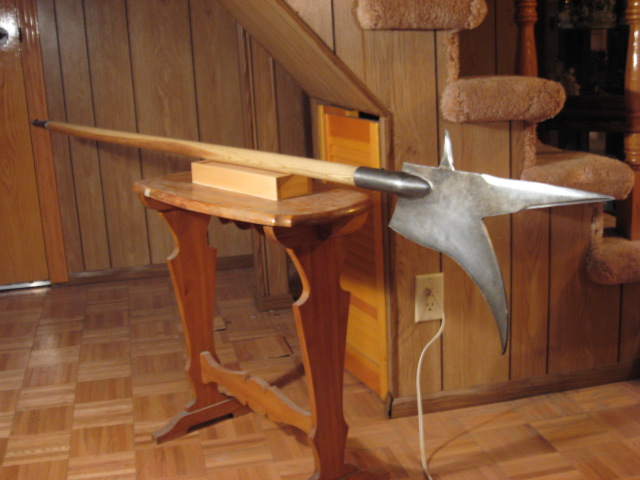
Low cealing: Only way I could show the whole thing !
 Attachment: 91.9 KB Attachment: 91.9 KB
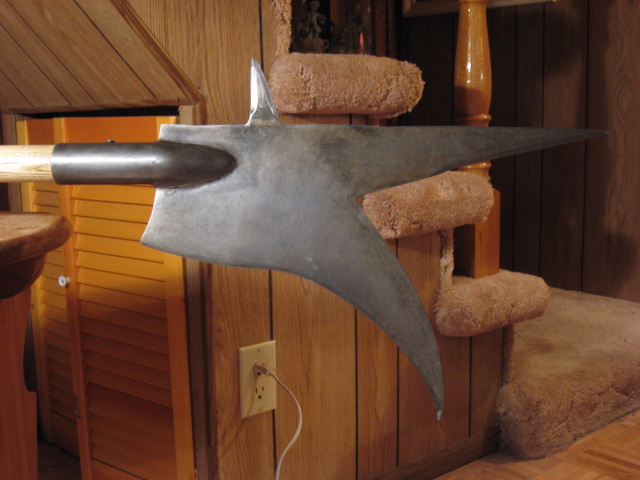
 Attachment: 80.76 KB Attachment: 80.76 KB
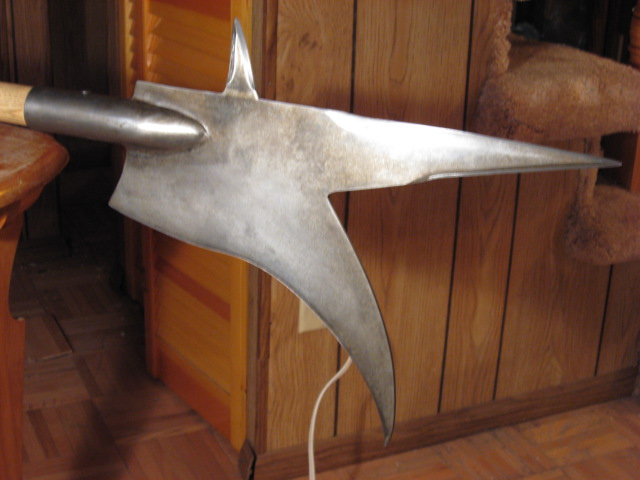
 Attachment: 92.47 KB Attachment: 92.47 KB
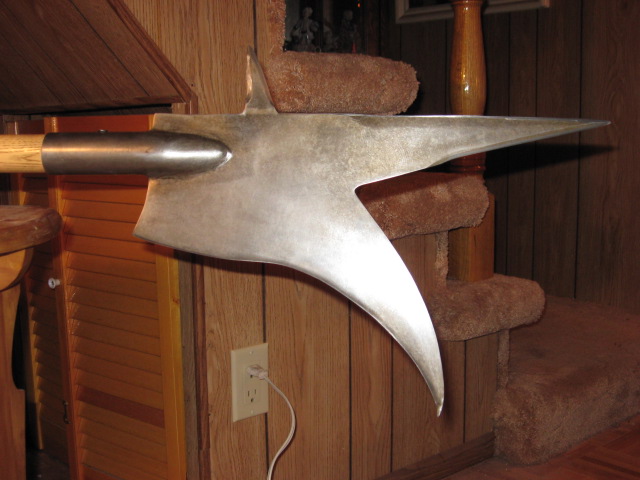
 Attachment: 62.23 KB Attachment: 62.23 KB
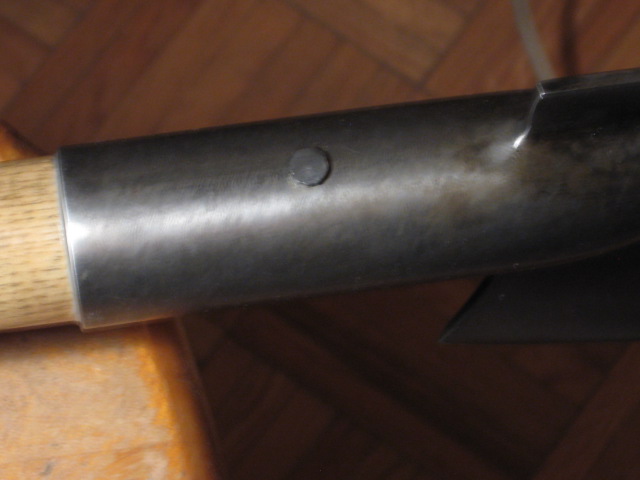
Steel pin + Epoxy holding it all together.
 Attachment: 63 KB Attachment: 63 KB
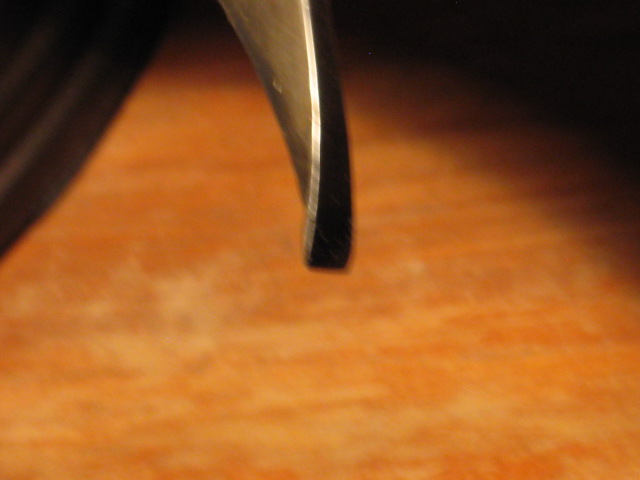
Adze/chisel edge close-up.
 Attachment: 81.25 KB Attachment: 81.25 KB
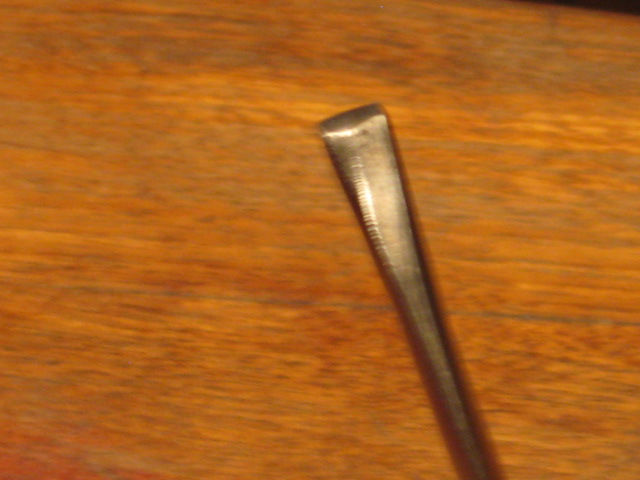
Adze/chisel edge different angle.
You can easily give up your freedom. You have to fight hard to get it back!
Last edited by Jean Thibodeau on Sun 08 Jan, 2012 10:47 pm; edited 2 times in total
|
|
  |
 |
Jean Thibodeau

|
 Posted: Sun 08 Jan, 2012 10:29 pm Post subject: Posted: Sun 08 Jan, 2012 10:29 pm Post subject: |
 |
|
A few more pics, showing the back spike and both sides of the Bill head, hopefully the finish/patina is somewhat visible in the various pics: Sort of difficult to light and photograph this as I'm still learning to use the camera and I am using improvised lighting in a small space and I also have to figure out how to use the macro setting and control the focus at times.
 Attachment: 73.56 KB Attachment: 73.56 KB
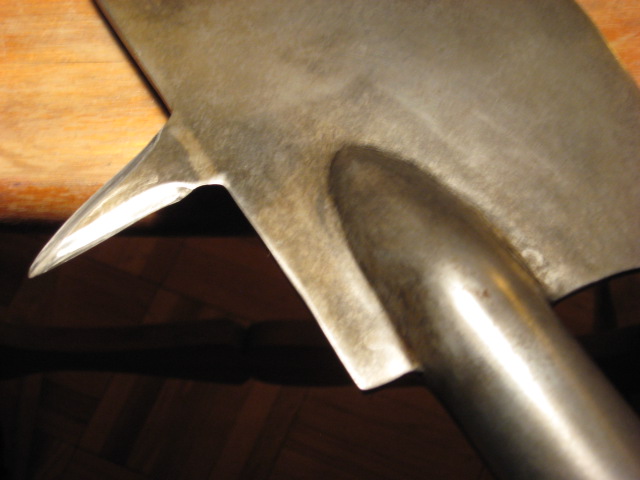
Back spike.
 Attachment: 75.07 KB Attachment: 75.07 KB
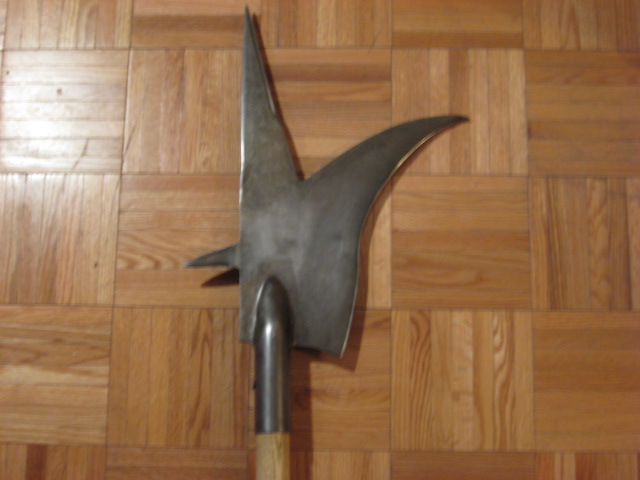
Right side of Bill.
 Attachment: 85.42 KB Attachment: 85.42 KB
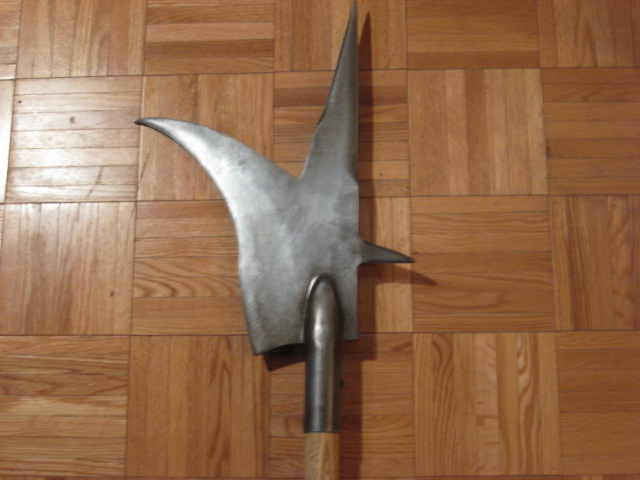
Left side of Bill.
You can easily give up your freedom. You have to fight hard to get it back!
|
|
  |
 |
|
Ken Speed
|
 Posted: Mon 09 Jan, 2012 10:33 am Post subject: Posted: Mon 09 Jan, 2012 10:33 am Post subject: |
 |
|
Jean!
Yikes!
Remind me never ,ever to get you angry! 
That bill is about as vicious looking a weapon as I've ever seen. It's like a medieval Bass o matic for people! "it slices, it dices, it purees!"
You gonna do test cutting with it? NO! Don't tell me, I don't want to know!
Don't let kids see it, they'll have nightmares!
Good for you! I bet you and Craig had fun!
|
|
  |
 |
|
Tim Lison
|
 Posted: Mon 09 Jan, 2012 10:56 am Post subject: Posted: Mon 09 Jan, 2012 10:56 am Post subject: |
 |
|
|
Nice one Jean! Nice choice on the customization. The little curve on the axe part makes a big difference! Congratulations. It is in good company with your partizan!
|
|
  |
 |
Corey Skriletz

Location: United States Joined: 27 May 2011
Posts: 118
|
 Posted: Mon 09 Jan, 2012 11:22 am Post subject: Posted: Mon 09 Jan, 2012 11:22 am Post subject: |
 |
|
|
Great job with the attachment of the shaft. Cutting the slit in it looks like it worked pretty well. Beautiful piece of work!
|
|
  |
 |
Jean Thibodeau

|
 Posted: Mon 09 Jan, 2012 2:45 pm Post subject: Posted: Mon 09 Jan, 2012 2:45 pm Post subject: |
 |
|
| Ken Speed wrote: | Jean!
Yikes!
Remind me never ,ever to get you angry! 
That bill is about as vicious looking a weapon as I've ever seen. It's like a medieval Bass o matic for people! "it slices, it dices, it purees!"
You gonna do test cutting with it? NO! Don't tell me, I don't want to know!
Don't let kids see it, they'll have nightmares!
Good for you! I bet you and Craig had fun! |
Test cutting is a little hard to do in a small interior space, the backyard is also postage stamp sized and I wouldn't want to give the neighbours heart attacks !
But, holding it " carefully " close to the head the main edges will cut paper easily when I test my sharpening: These things can be very butter knife sharp and still be effective even when not heat treated as they often where not heat treated in period when made for the common soldier as " munitions " arms or improvised peasant weapons.
Although I think this might vary greatly ? For example a heat treated sickle used for agriculture might have had heat treated edges and when repurposed and remounted for war by the local blacksmith would probably still be heat treated.
Craig should chime in here as he has done a lot of research about this and better qualified to give accurate information rather than my " speculations ". 
Polearms made for the rich or their elite guards might in some cases, depending on type, be heat treated, but I wanted mine heat treated anyway.
You can easily give up your freedom. You have to fight hard to get it back!
|
|
  |
 |
Jean Thibodeau

|
 Posted: Mon 09 Jan, 2012 2:55 pm Post subject: Posted: Mon 09 Jan, 2012 2:55 pm Post subject: |
 |
|
| Corey Skriletz wrote: | | Great job with the attachment of the shaft. Cutting the slit in it looks like it worked pretty well. Beautiful piece of work! |
The slit is way up in the tapering part of the socket and not extending into the lower cylindrical part of the socket: So it's mostly invisible but it would also keep the head from rotating on the haft, but this is very " theoretical " as an advantage since the steel pin + the epoxy does the job more than well enough.
By the way, the pin is actually a heat treated masonry nail and what is visible is the flat nail head, the pin itself is 1/8" in diameter.
The hole was drilled into the socket and the haft slightly over sized and epoxy makes sure it doesn't fall out.
You can easily give up your freedom. You have to fight hard to get it back!
|
|
  |
 |
|
William P
|
 Posted: Tue 10 Jan, 2012 1:04 am Post subject: Posted: Tue 10 Jan, 2012 1:04 am Post subject: |
 |
|
... the ONLY reason i might find a poleaxe slightly less scary then this is that with a poleaxe your in danger no matter wat armour your wearing,
but facing this as a reletively unarmoured footsoldier with just padded jack, doublet and jack chains on my arms,
a good way to assess its pure edge sharpness jean, would be to fasten the sickle edge facing upwards and simply hit the edge with a tatami roll or something, at sword strike sort of forces, i realise theres more to the power of a slice than the edge sharpness alone, but itll give an idea of what happens when the tatami, or whatever cutting media you choose, and the edge collide with a decent amount of momentum.
definately gives me a newfound respect for bills (personally i prefer items like the bec de corbain and swiss halberd.)
|
|
   |
 |
Craig Johnson
Industry Professional

|
 Posted: Tue 10 Jan, 2012 8:49 am Post subject: Heat treat of pole arms Posted: Tue 10 Jan, 2012 8:49 am Post subject: Heat treat of pole arms |
 |
|
Hi Guys
I am glad folks appreciate Jean's project. He did a great job mounting the head and I like his finish quite a bit as well. Good job Jean!
As to the heat treat of the head, it is something that not a great deal of research has been done on. Williams has an article that deals with testing a pole arm head and I have been around when some surface testing has been done. Also the constructional elements that would affect it are dealt with a bit in the Hafted Weapons in Medieval and Renaissance Europe book.
The main issue is that iron was probably used in most pole weapons so even if one attempted to heat treat it would not go hard. You would have to carbonize the area first and with the larger items that would be more difficult. As one gets into the later Renaissance I am not sure if this held true. Some of the big partisan may have been made from steel. Mu guess is they would rely on work hardening for the edges but they may have tried some heat treat.
I think it would be pretty unlikely that many pole arms before this would have been done at all though. One did not need to rely on the hardness of the edge as weight and speed are far more important for the physics of their use. Where you do see the attention to the harder edges is in the hand axes. Things like the Danish War axe and the fighting hand axes probably where done.
Best
Craig
|
|
    |
 |
Benjamin H. Abbott

|
 Posted: Tue 10 Jan, 2012 2:35 pm Post subject: Posted: Tue 10 Jan, 2012 2:35 pm Post subject: |
 |
|
Lovely weapon, Jean. An even shorter haft makes sense to me, given both the recommendations of period writers as well as my experience handling the standard A&A model.
Now, on the subject of heat treatment and carbon content. Sixteenth-century sources such as Sir Roger William emphasized the importance of robust construction for bills and halberds. Williams specifically desired halberds made of "good stuffe" rather than those crafted from "naughtie stuffe like our common browne bills." Henry Barrett mentioned a "well stieled" point for the lead maul he wanted archers to carry. Of course, we don't know exactly what he meant by steel. However, these texts together suggest that the quality of the metal and manufacturing of polearms varied significantly and this difference mattered on the battlefield.
Also, various museum collections distinguish between iron and steel. If they do so accurately, many polearms contained steel.
|
|
  |
 |
Jean Thibodeau

|
 Posted: Tue 10 Jan, 2012 4:05 pm Post subject: Re: Heat treat of pole arms Posted: Tue 10 Jan, 2012 4:05 pm Post subject: Re: Heat treat of pole arms |
 |
|
| Craig Johnson wrote: | Hi Guys
I am glad folks appreciate Jean's project. He did a great job mounting the head and I like his finish quite a bit as well. Good job Jean!
|
Thanks Craig, and you might want to experiment with this type of finish using the Dijon Mustard ( Common yellow mustard works also, but somehow the Dijon seems to give very good results ).
it basically took only a couple of hours to get this finish done, most of it waiting for the mustard to dry out.
A) Apply.
B) Let dry in about an hour or two.
C) Clean off with soap and water.
D) Lighten the finish with synthetic steel wood.
E) Repeat a few times to build up patterns of patination, re-darken if one polished too much or polish back up to just a hint of patina but you should still have a bit of activity on the surface hiding very well modern looking tool marks or directional sanding marks giving an old but clean surface.
F) A coat of Breakfree or other quality gun oil to protect the surface and avoid having any red rust formation.
What might be interesting for you is that this wouldn't add much work time, cost or add too much to the prices, so it might be an option you could offer ? I'm sure you have other techniques you have used for some pieces you made with antiqued finishes but that involved a great deal of more work time for you. ( NOTE: A lot depending on the degree of antiquing desired, and the specific effect desired and matching more closely the real effects of time ).
You can easily give up your freedom. You have to fight hard to get it back!
|
|
  |
 |
Jean Thibodeau

|
 Posted: Tue 10 Jan, 2012 4:11 pm Post subject: Posted: Tue 10 Jan, 2012 4:11 pm Post subject: |
 |
|
Oh, Craig, you might also give us more background information about that reinforced tip as it was something I had never seen before, although I think it's a very useful and smart design to reinforce the tip very different from the more obvious way of thickening into a diamond section point.
You can easily give up your freedom. You have to fight hard to get it back!
|
|
  |
 |
|
William P
|
 Posted: Tue 10 Jan, 2012 6:48 pm Post subject: Posted: Tue 10 Jan, 2012 6:48 pm Post subject: |
 |
|
| Jean Thibodeau wrote: | | Oh, Craig, you might also give us more background information about that reinforced tip as it was something I had never seen before, although I think it's a very useful and smart design to reinforce the tip very different from the more obvious way of thickening into a diamond section point. |
i would have, as a gut feeling gone more for the reinforced diamond,
considering that when armour piercing is needed points always went diamond, sword blades, arrowheads and daggers
i wonder if it would add any benefit to sharpen the entire perimeter of the head? including the junction between the the top edge of the sickle and the top spike.
also, that adze like point would make it devastating against shields
and ken, once when my aunts little boy saw my blunted danish axe at home, i held it up and he said 'thats for cutting down trees and killing people'
i replied, 'nope, this isnt made for cutting trees, but for cutting down people' sometimes im alittle too honest for my own good.
(the kid was about 5, he loved my description :P )
|
|
   |
 |
Jean Thibodeau

|
 Posted: Tue 10 Jan, 2012 10:21 pm Post subject: Posted: Tue 10 Jan, 2012 10:21 pm Post subject: |
 |
|
| William P wrote: |
i wonder if it would add any benefit to sharpen the entire perimeter of the head? including the junction between the the top edge of the sickle and the top spike.
|
I tend to think it's sharp where it needs to be and any part of it not sharpened would be very unlikely to be used effectively.
As to the junction between the top spike and the curved sickle/axe part I think it would be most usefully used to parry/block/push an opponent's weapons or their body.
The sickle part would be very good in getting behind the knees of even a fully armoured opponent and cut them behind the knee or at the very least trip them and bring them down to the ground.
" Le Jeu de la Hache " has all sort of jamming and trapping techniques where the " cross " of a poleaxe can be used to push or pull or rip the weapons out of the hands of the opponent.
The English Bill can be used in many similar ways and even though the head is more optimized to chop or cut I wouldn't underestimate the power of a strong blow even on the plate armour: Would not cut through it but there is still weight enough to do damage or stun I think.
Although the English Bill may not typically have used a steel butt, I think mine could do a lot of concussive damage if thrust like a battering ram into armour and hit as hard as a mace head.
You can easily give up your freedom. You have to fight hard to get it back!
|
|
  |
 |
Benjamin H. Abbott

|
 Posted: Wed 11 Jan, 2012 9:27 am Post subject: Posted: Wed 11 Jan, 2012 9:27 am Post subject: |
 |
|
| Jean Thibodeau wrote: | | The English Bill can be used in many similar ways and even though the head is more optimized to chop or cut I wouldn't underestimate the power of a strong blow even on the plate armour: Would not cut through it but there is still weight enough to do damage or stun I think. |
Sir John Smythe instructed halberdiers - a category that included those armed with the bill, as they're nearly the same weapon - to strike at the head and thrust at the face in battle. That suggests the effectiveness of blows against helmets. Accounts from Flodden Field in 1513 present the picture of heavily armored Scots battered into submission by English bills. The Scots "were such large and strong men, they would not fall when four or five bills struck one of them."
|
|
  |
 |
Gordon Frye

|
 Posted: Wed 11 Jan, 2012 5:06 pm Post subject: Posted: Wed 11 Jan, 2012 5:06 pm Post subject: |
 |
|
Jean;
That's a really cool bill! Glad you finally got it into your hot little hands...I remember you talking about ordering it some time ago, so it's nice that you finally get to play with it!
May years ago (several decades now, in fact!) I made myself up a "do-it-yourself" bill from a brush-hook. I riveted a socket to the bottom of it and a spike to side, extending to the top, then mounted the whole contraption on a stout pole of about 6' in length. It was pretty wicked, and I wish I had hung on to it, Somewhere down the line though someone decided that they needed it more than I did, so off it went. Alas!
Anyway, it proved to be one of the most effective pole-arms I've ever had the pleasure of playing around with. I remember an SCA friend donated an old but fairly well built helmet to the cause, and I gave it a good swing and "SCHUNK!", the "beak" sank into the top of the helmet to the edge of the blade! Now admittedly, the brush-hook was probably of much better steel than one would have found in 16th Century England, and the helmet, good as it was, probably wasn't of the finest surface-hardened iron, but still, it was amazing how buttery-soft that helmet felt when the bill was sinking into it! The big wedge-shaped holes that it left were pretty impressive as well! I assuredly would NOT have wanted to have been wearing that helmet when it was hit by the bill!
So there it is, Bills as a Serious Weapon! Glad you finally got it, and thanks for sharing the photo's with us!
Cheers!
Gordon
"After God, we owe our victory to our Horses"
Gonsalo Jimenez de Quesada
http://www.renaissancesoldier.com/
http://historypundit.blogspot.com/
|
|
    |
 |
Craig Johnson
Industry Professional

|
 Posted: Wed 11 Jan, 2012 7:23 pm Post subject: Tip geometry Posted: Wed 11 Jan, 2012 7:23 pm Post subject: Tip geometry |
 |
|
Evenin Guys
The geometry of the tip is something I found on an original halberd first. It was probably about 20 years ago now, crap I am old  and was in a private collection in Wisconsin. I was surprised to see this chisel shaped point. But when one thinks about it in the context of why would they do this, it is easy to see that it focuses the force on a stout edge tip than a more fragile point. Over time I have found the tip on many different examples of pole arms with a forward facing point. and was in a private collection in Wisconsin. I was surprised to see this chisel shaped point. But when one thinks about it in the context of why would they do this, it is easy to see that it focuses the force on a stout edge tip than a more fragile point. Over time I have found the tip on many different examples of pole arms with a forward facing point.
The detail is something that is relatively complex as it does not have a sharp edge all the way to the point but rather fades to the chisel edge over the last short distance. This shape has great penetrating power and transitions into a pretty stout cutting edge. When I have used this shape on things it has a tendency really "open things up" as it where 
The actual percentage of weapons with this type point I have no idea, but I have probably seen at least twenty examples if not more and think it would have been something that would have been a known design element in the repertoire of the pole arm maker.
Best
Craig
|
|
    |
 |
Jean Thibodeau

|
 Posted: Wed 11 Jan, 2012 8:23 pm Post subject: Re: Tip geometry Posted: Wed 11 Jan, 2012 8:23 pm Post subject: Re: Tip geometry |
 |
|
| Craig Johnson wrote: | Evenin Guys
The geometry of the tip is something I found on an original halberd first. It was probably about 20 years ago now, crap I am old  and was in a private collection in Wisconsin. I was surprised to see this chisel shaped point. But when one thinks about it in the context of why would they do this, it is easy to see that it focuses the force on a stout edge tip than a more fragile point. Over time I have found the tip on many different examples of pole arms with a forward facing point. and was in a private collection in Wisconsin. I was surprised to see this chisel shaped point. But when one thinks about it in the context of why would they do this, it is easy to see that it focuses the force on a stout edge tip than a more fragile point. Over time I have found the tip on many different examples of pole arms with a forward facing point.
The detail is something that is relatively complex as it does not have a sharp edge all the way to the point but rather fades to the chisel edge over the last short distance. This shape has great penetrating power and transitions into a pretty stout cutting edge. When I have used this shape on things it has a tendency really "open things up" as it where 
The actual percentage of weapons with this type point I have no idea, but I have probably seen at least twenty examples if not more and think it would have been something that would have been a known design element in the repertoire of the pole arm maker.
Best
Craig |
And as in Gordon's example I think this point would very much act like a can opener and if the steel is pierced initially by this point the way is opened for the edge following the point to continue cutting into the plate, maybe. 
Actually when one uses a can opener the most difficult part is the initial start in piercing a can and then the can opener just seems to cut with little effort.
At the very least it keep the point from being fragile and breaking off.
You can easily give up your freedom. You have to fight hard to get it back!
|
|
  |
 |
Terry Thompson

Location: Suburbs of Wash D.C. Joined: 17 Sep 2010
Posts: 165
|
 Posted: Wed 07 Mar, 2012 7:30 am Post subject: Posted: Wed 07 Mar, 2012 7:30 am Post subject: |
 |
|
I love that bill, Jean!
I've recently purchased a bill head and having a bit of mental conundrum with the length of the pole mounting. I read that George Silver in 1599 wrote that Black Bill (military) should be about 5 or 6' in length. Where as a forest (brown) bill would be in the order of 8' or 9'.
I can see the 8' to 9' of a brown bill in over all length, being that an agricultural impliment being used primarily to reach up into tree limbs and might have a somewhat smaller head without the pointy bits. But conversely the length of 5 or 6' seems a bit short in over-all length when considering the head is somewhere in the neighborhood of 20"+ (50cm+) long including its end spike (not including the socket or langets for mounting).
The one I'm getting is a bit more like the A&A italian Bill in style, but more angular on the chopping part.
What's the general concensus of a proper black bill length? Does one include the projecting spike in the over-all 5-6' length when the spike itself is nearly a foot long?
I can always cut the pole shorter, but adding on length is not as easy : )
|
|
  |
 |
|
William P
|
 Posted: Wed 07 Mar, 2012 8:44 pm Post subject: Posted: Wed 07 Mar, 2012 8:44 pm Post subject: |
 |
|
| Jean Thibodeau wrote: | | William P wrote: |
i wonder if it would add any benefit to sharpen the entire perimeter of the head? including the junction between the the top edge of the sickle and the top spike.
|
I tend to think it's sharp where it needs to be and any part of it not sharpened would be very unlikely to be used effectively.
As to the junction between the top spike and the curved sickle/axe part I think it would be most usefully used to parry/block/push an opponent's weapons or their body.
The sickle part would be very good in getting behind the knees of even a fully armoured opponent and cut them behind the knee or at the very least trip them and bring them down to the ground.
" Le Jeu de la Hache " has all sort of jamming and trapping techniques where the " cross " of a poleaxe can be used to push or pull or rip the weapons out of the hands of the opponent.
The English Bill can be used in many similar ways and even though the head is more optimized to chop or cut I wouldn't underestimate the power of a strong blow even on the plate armour: Would not cut through it but there is still weight enough to do damage or stun I think.
Although the English Bill may not typically have used a steel butt, I think mine could do a lot of concussive damage if thrust like a battering ram into armour and hit as hard as a mace head. |
also, and while this applies alittle more easily to pollaxes, or items with shorter hafts of 6 foot or less, but i find when in the halberd position of holding it so that the butt is facing the enemy,
a REALLY natural move one can employ when someone rushes at you suddenly, prefenting you from employing the head of the halberd.
is one move employed by modern footsoldiers andpringing the weapon up, horizontal, above your shoulder and slamming the butt into your opponents face or head
when you have a 4 foot danish axe, against a metre long sword and roundshield
for the common soldeir of most of history, where face protection wasnt employed, whether you have a celata, kettle hat, bascinet or burgonet, that will be a devestating move to exposed faces and will still stun a guy even with face protection
and i suggested sharpening all surfaces of the since i was inspired by the method of using the shaolin monk spade,
and the cross shaped spear (jumonji yari) of japan, where it has two side projections.
one scenario in the pretty realistic manga vagabond, one scenario which almost happens to musasshi is that the projections of the yari are sharpened like long flukes, and even if the spearhead misses hitting the throat, the 'lugs' of the spear will slice into the neck, delivering a fatal blow anyway
if the top surface of the bill was sharpened as well, even a thrust with the top spike that misses the neck or arms will still cause a slicing wound as the sharpened surface of the bill contacts the target. and of course being a sickle, you can then orint the sickle to slice when pulling the head back to the ready position.
|
|
   |
 |
|
|
You cannot post new topics in this forum
You cannot reply to topics in this forum
You cannot edit your posts in this forum
You cannot delete your posts in this forum
You cannot vote in polls in this forum
You cannot attach files in this forum
You can download files in this forum
|
All contents © Copyright 2003-2025 myArmoury.com — All rights reserved
Discussion forums powered by phpBB © The phpBB Group
Switch to the Basic Low-bandwidth Version of the forum
|

